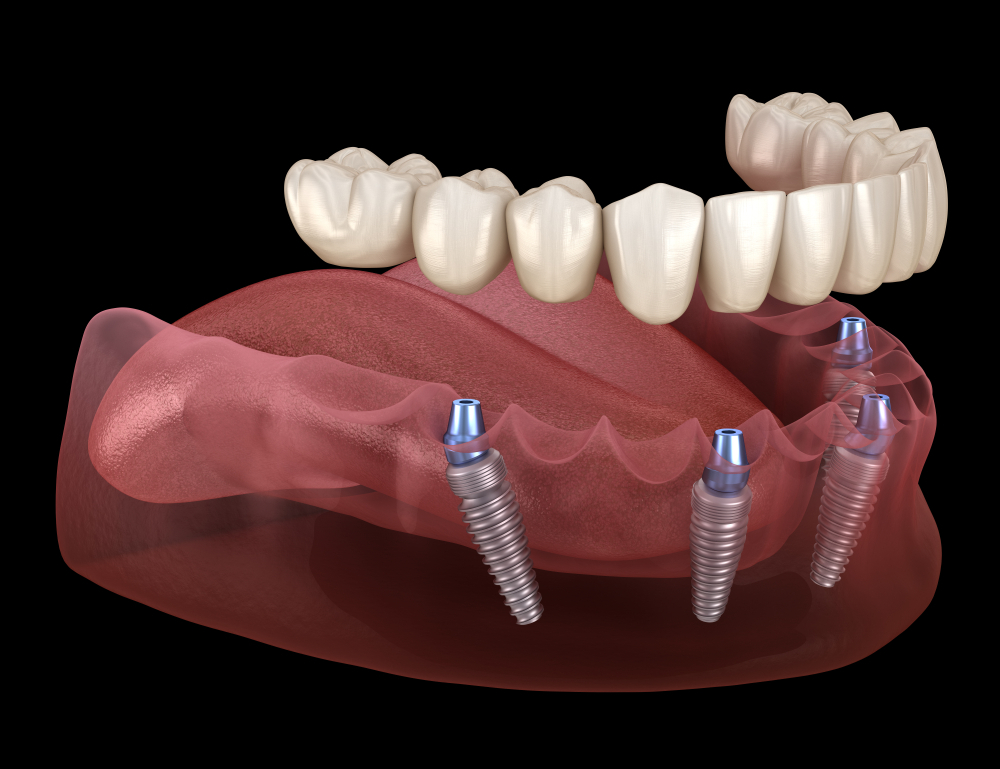FACTORS TO CONSIDER WHEN RECOMMENDING ALL-ON-FOUR
ALL-ON-FOUR – Improved dental hygiene over the last couple of decades, edentulism remains common among elderly patients. Complete edentulism, which is often a result of both caries, poor oral hygiene, and periodontal disease, has a detrimental effect in the patient’s dental and general health and overall sense of well-being. Dentures will be the standard treatment for edentulism. Clinical studies have demonstrated that patients supplied with dentures may anticipate only a marginal increase in quality of life when compared to patients who receive implant.
Unfortunately, not every patient can have traditional implant therapy, which necessitates multiple implants to restore a complete arch of teeth. As life expectancies increase, clinicians are faced with providing reliable, affordable solutions for patients who might not need (or be able to experience) lengthier implant treatments in which multiple implants, bone, or soft tissue regeneration are demanded. All-on-four provides an alternate solution.

When to Suggest All-On-Four
All-on-four Is a treatment theory that provides patients with an immediately-loaded prosthesis supported by four implants. It is very effective for patients with poor bone quality or quantity or at which bone augmentation could be hard or inadvisable. All-on-four allows for the positioning of longer implants that provide greater anchorage and encourage and maintain anatomical structures. Tilting the distal implants maximizes utilization of bone when reducing the cantilever span from the jaw. Several
studies have found that tilting these implants generates reliable clinical outcomes. As Patients become more aware of the choices, they might request this therapy without understanding what is involved or how it may benefit them. This therapy gives a predictable outcome, providing patients a high degree of satisfaction concerning operation and esthetics. Even though it can be a superb option, there are several facets worth talking with the individual when suggesting it as a possible solution.
The Possible Bulkiness of an All-On-Four Bridge
Some People find it hard to adapt to the sense of an all-on-four bridge due to its bulkier design. If they are only expecting to obtain replacement teeth, it may be a jolt to also feel replacement gum tissue. Showing them models of conventional full-arch bridges in comparison using an all-on-four bridge will help them adapt to the idea and prepare them to the look and feel of the new bridge after surgery.
When they have concerns, you may always discuss alternative remedies. Many patients select all-on-four due to its affordability but will be more prepared to pursue alternative therapies. When they fully informed of all their treatment options.
Modifications to Speech
Often With all-on-four it’s necessary to replace bone and soft tissue along with teeth. For the strength of the implant the bridge will likely need to be hulking compared to the patient’s first tissues. The increase in bulk affects speech but, in time, this may be overcome by retraining the tongue. The individual may initially find it more challenging to clearly enunciate sounds generated when the tongue contacts the palate. Just over the central upper incisors. Difficult sounds of “N,” “D,” and “T.” They may also find it more difficult to clearly produce “S” sounds.
If speech is a specific concern, it could cause stress, and the patient may prefer to consider less bulky alternative remedies. One option is to attempt to save some natural teeth, rather giving a bridge that only replaces teeth that are no longer workable.
Saving natural teeth will be likely to boost the price and time required for treatment. Alternative therapy options may require additional enhancements and bone grafting. If some natural teeth saved. Then the individual must understand the significance of caring for these teeth. Especially if natural teeth have been lost as a result of disease or neglect. Some patients may be unable or unwilling to modify their habits, in which case an overdenture provides an individualized oral hygiene routine.
Parafunction and Proprioception
Parafunctional practice, including bruxism “grinding teeth”, could impact the options you recommend to the individual. Implants, particularly duil-arch all-on-four restorations, do not detect forces as easily as ordinary teeth. Periodontal mechanoreceptors raise the sensitivity of natural teeth forces, and dental implants shed this feedback. When both arches require treatment, it may be well worth attempting to save at least a couple natural teeth in order to register these forces. Otherwise consider restoring the maxilla first, so the patient may more easily learn when they are using excess force.
Restoring One arch at a time gives the patient an opportunity to develop mechanoreceptors in their facial muscles and joints. Another choice is to utilize a bar-supported overdenture. While an all-on-four procedure, the prosthesis will obviously not be fixed. This means the overdenture can be taken out at night and replaced with. A night guard that can snap onto the bar, providing protection for bruxers. But for many people the appeal of all-on-four lies in using a fixed arch prosthesis. So the bar-supported overdenture may initially seem less appealing.
Despite The possible limitations of all-on-four implant remedies. These dental implants provide excellent potential for significantly enhancing the quality of life for edentulous patients when compared with traditional dentures. If you currently have elderly patients who are struggling with inadequate denture stability, discomfort, and problems eating. All-on-four might be a convenient and affordable treatment choice. All-on-four offers a predictable outcome, is not as invasive. It is easier for an older patient along with other health issues to tolerate. When helping the patient select a treatmen. It’s necessary to talk about all probable choices in order that they feel fulfilled and able to make the right choice for their needs.
Having Dental Treatment in Turkey,
Due to its rapid medical development, skilled doctors and the low treatment costs, Turkey has emerged as one of the top medical tourism destinations for dental treatments.
Our experienced technical staff at Health&Beauty is here to assist you if you wish to discuss your case in more detail.
Request Free Consultation!
